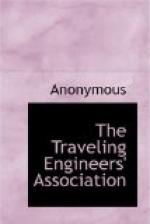139. Q. Explain the operation of the distributing valve when making an independent application of the brake.
A. When the independent brake valve handle is moved to application position, air is admitted from the reducing valve pipe through the application cylinder pipe to the application chamber and cylinder. Pressure forming in the application cylinder will move the application piston 10 to the right, carrying with it the exhaust valve 16 and the application valve 5, closing the exhaust port and opening the supply port, admitting main reservoir air from chamber “a” to the brake cylinders (see Fig. 12) until the pressure in the brake cylinders and chamber “b” slightly exceeds that in chamber “g”, when the application piston 10 and valve 5 will move back to lap position. By moving the brake valve handle to either release or running position, the air is exhausted from the application cylinder and chamber, thus reducing the pressure in chamber “g”, allowing the pressure in chamber “b” to force the piston to the left, carrying with it the exhaust valve 16, opening the exhaust ports “e” and “d”, allowing the air from the brake cylinders to escape to the atmosphere, thus releasing the brake.
DISTRIBUTING VALVE DEFECTS
140. Q. If the locomotive brake released with the automatic brake valve in lap position, where would you look for the trouble?
A. Would look for a leak in the application cylinder pipe or in the application cylinder cap gasket.
141. Q. If the brake remained applied in lap position, but released in release or holding position, where would you look for the trouble?
A. Would look for a leak in the distributing valve release pipe.
142. Q. If the distributing valve release pipe and application cylinder pipe were crossed, what would be the effect?
A. A brake application made by the automatic brake valve cannot be released by the independent brake valve.
143. Q. If the safety valve leaks, what will be the effect?
A. This may prevent the brake applying, and in an independent application if the brake does apply, it will release when the brake valve is returned to lap position.
BROKEN PIPES
144. Q. If the main reservoir supply pipe to the distributing valve breaks, what should be done?
A. Plug the pipe toward the main reservoir. The locomotive brake is lost, but if the distributing valve is equipped with a quick action cap, when an emergency application is made, the air coming from the brake pipe, through the quick action cap, will apply the locomotive brake.
145. Q. If the application cylinder pipe breaks, what effect will it have on the locomotive brake?
A. The locomotive brake cannot be applied with either automatic or independent brake valve. By plugging the pipe toward the distributing valve the automatic brake will be restored.




